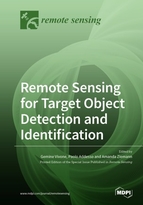Remote Sensing for Target Object Detection and Identification
A special issue of Remote Sensing (ISSN 2072-4292). This special issue belongs to the section "Remote Sensing Image Processing".
Deadline for manuscript submissions: closed (31 October 2019) | Viewed by 66305
Special Issue Editors
Interests: statistical signal processing; detection of remotely sensed images; data fusion; tracking algorithms
Special Issues, Collections and Topics in MDPI journals
Interests: remote sensing; image processing; signal processing; sequential Bayesian estimation; estimation theory; detection theory; statistical signal processing; fractal models; data fusion; gravitational waves; localization; nonlinear devices; sensor networks
Special Issues, Collections and Topics in MDPI journals
Special Issue Information
Dear Colleagues,
Target object detection and identification is one of the main tasks for a remote sensing system and is of paramount importance in several fields, including environmental and urban monitoring, geological research, hazard and disaster management, and emergency/security and military applications. Moreover, the huge amount of data acquired nowadays by sensors on-board satellite platforms allows for the development of new methodologies to properly address this specific remote sensing task.
Thus, this Special Issue focuses on presenting the latest advances and trends for target object detection and identification within the wide field of remote sensing. Both methodological/theoretical and application-oriented papers are welcome. This Special Issue will cover (but will not be limited to) the following topics:
- Target object detection, tracking, and identification for the environmental monitoring of the atmosphere (e.g., cloud and plume detection/identification);
- Target object detection, tracking, and identification for the environmental monitoring of the sea (e.g., sea ice monitoring, iceberg tracking, oil spills);
- Target object detection, tracking, and identification for security and military applications;
- Target object detection and identification for urban monitoring (e.g., change detection);
- Optical and/or infrared data for target object detection and identification;
- Radar and/or SAR data for target object detection and identification;
- Multi-sensor (spatio-temporal, spatio-spectral, and multimodal) data fusion for target object detection and identification;
- Methods, algorithms, and theoretical models for target object detection, tracking, and identification;
- Machine learning for target object detection, tracking, and identification.
Dr. Paolo Addesso
Dr. Amanda Ziemann
Guest Editors
Manuscript Submission Information
Manuscripts should be submitted online at www.mdpi.com by registering and logging in to this website. Once you are registered, click here to go to the submission form. Manuscripts can be submitted until the deadline. All submissions that pass pre-check are peer-reviewed. Accepted papers will be published continuously in the journal (as soon as accepted) and will be listed together on the special issue website. Research articles, review articles as well as short communications are invited. For planned papers, a title and short abstract (about 100 words) can be sent to the Editorial Office for announcement on this website.
Submitted manuscripts should not have been published previously, nor be under consideration for publication elsewhere (except conference proceedings papers). All manuscripts are thoroughly refereed through a single-blind peer-review process. A guide for authors and other relevant information for submission of manuscripts is available on the Instructions for Authors page. Remote Sensing is an international peer-reviewed open access semimonthly journal published by MDPI.
Please visit the Instructions for Authors page before submitting a manuscript. The Article Processing Charge (APC) for publication in this open access journal is 2700 CHF (Swiss Francs). Submitted papers should be well formatted and use good English. Authors may use MDPI's English editing service prior to publication or during author revisions.
Keywords
- Remote sensing
- Data fusion
- Machine learning
- Signal processing
- Detection theory
- Classification
- Target tracking








